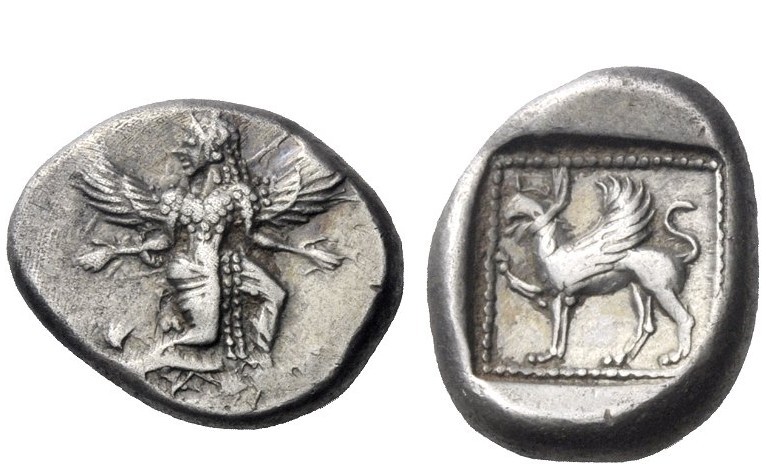AC 233 - Caunus, silver, hemidrachm, 490-470 BC
From SILVER
490 BCE - 470 BCE Silver 1,035 kg
Description
| ObverseInscription or printing placed on the obverse.: | Winged Iris, with outstretched hand, kneeling-running right, head turned back, two scrolls curling up from the top of her head. |
| ReverseInscription or printing placed on the reverse.: | Griffin standing left, right forepaw raised, within incuse square with dotted border. |
Mint and issuing power
| MintIdentifies the place of manufacture or issue of a numismatic object.: | Caunus | Ancient regionAncient region.: | Caria | Modern countryModern country: Turkey | AuthorityIdentifies the issuing power. The authority can be "pretended" when the name or the portrait of X is on the coin but he/she was not the issuing power. It can also be "uncertain" when there is no mention of X on the coin but he/she was the issuing power according to the historical sources: |
Chronology
| FromIdentifies the initial date in a range assigned in a numismatic context. | 490 BCE | toIdentifies the final date in a range assigned in a numismatic context.. | 470 BCE | PeriodTime period of the numismatic object.: Archaic and Classical |
Physical description
| MetalThe physical material (usually metal) from which an object is made.: | Silver |
Median weightMedian of the weights of numismatic objects (in grams). in grams | 2.45 | DenominationTerm indicating the value of a numismatic object. Examples: tetradrachm, chalkous, denarius.: | hemidrachm |
StandardStandard.: |
Image

AC233 Caunus.jpeg [1]
References
| Die study referencePublication of the study: | Konuk 19981Konuk 1998, n° 21-45. | ||
| Coin series referenceReference to coin series study: | RQEMAC2RQEMAC, n° 233 | ||
| Coin series web referenceCoin series web references: | |||
Obverse dies distribution
| FrequencyFrequency of specimen in distribution. ᵖ | Number of obversesNumber of obverse dies. ᵖ (o) | % (o) | Number of coinsNumber of coins. (n) | % (n) | Die nameName(s) of the die(s). |
| 1 | 11 | 61.11 | 11 | 15.71 | 2, 3, 4, 6, 9, 11, 12, 13, 15, 16, 18 |
| 2 | 1 | 5.56 | 2 | 2.86 | 8 |
| 3 | 1 | 5.56 | 3 | 4.29 | 5 |
| 4 | 1 | 5.56 | 4 | 5.71 | 7 |
| 5 | 1 | 5.56 | 5 | 7.14 | 14 |
| 6 | 1 | 5.56 | 6 | 8.57 | 17 |
| 13 | 1 | 5.56 | 13 | 18.57 | 1 |
| 26 | 1 | 5.56 | 26 | 37.14 | 10 |
| Total | 18 of 18 | 100.03 | 70 of 70 | 99.99 |
Reverse dies distribution
no distribution is available
Quantification
| Number of obversesNumber of obverse dies. ᵖ (o) | 18 | Number of singletons (o1)The number of singleton coins. ᵖ | 11 |
| Number of reverse diesNumber of reverse dies. (r) | 23 | Number of coinsNumber of coins. (n) | 70 |
| Coins per obverse dieNumber of coins per obverse die. (n/o) | 3.89 | Coins per reverse dieNumber of coins per reverse die. (n/r) | 3.04 |
| Reverse per obverse ratioRatio of obverse dies divided by reverse dies. (r/o) | 1.28 | Percentage of singletons (o1)number of coins (n) divided by the number of singletons (o1) ᵖ | 61.11 % |
| Original number of dies (O) (Carter 1983 formula)The estimation of the number of coins according to Carter 1983 ᵖ | 21.12 | Coins struck if 20,000 as average productivity per dieCoins made if the average productivity for obverses (according to Carter) is 20,000. ᵖ | 422,400 |
| Original number of dies (O) (Esty 2011 formula)The estimation of the number of coins according to the singleton formula in Esty 2011 ᵖ (O) | 24.23 | Survival rate if 20,000 as average productivity per dieSurvival rate if average productivity is 20,000. ᵖ | 0.00017 |
| Coverage (o = % of O) (Esty 1984 formula)Esty 1984 - coverage (% of O) ᵖ (o = % of O) | 84.29% | Die productivity if survival rate 1/2,000Average productivity if survival rate is 1/2,000. ᵖ | 6,628.79 |
| Weight of silver (in kg) if 20,000 coins per die (O = Carter formula)Carter 1983 * Median weight * 20000 (*10 if gold or electrum) ᵖ | 1,035 kg <br /> 1,035 kg | Die productivity if survival rate 1/5,000Average productivity if survival rate is 1/5,000. ᵖ | 16,571.97 |
Remarks
Most likely one single workstation